Whole house water filters are a big investment, and you don’t want to rush into buying one.
Just like washing machines and dishwashers, whole house filtration systems come in tens of different varieties, at a range of price points – and not all of them are worth your money.
Before you start shopping for a whole house filter system, you need to know:
- Exactly what’s available to you
- How the different types of whole house water filters work
- What each type of filter system can remove
We’ve created this comprehensive guide to help anyone who wants to learn more about whole house water filters, but isn’t ready to buy a system just yet.
We’ll be looking at each type of whole house water filter in detail, examining what it does, what it removes, and the pros and cons of installing the system in your home.
Table of Contents
🆚 Tank Based Systems vs Cartridge Based Systems
There are two common whole house water filtration system types:
- Tank-based systems
- Cartridge-based systems
Tank-based filtration systems use a large tank, filled with a filtration media.
Cartridge-based systems use a filter housing that contains around three filter cartridges, each with their own separate media.
Pros and Cons of Tank-Based Systems
Pros:
- The filter media typically lasts an average 3 to 5 years, so maintenance is minimal
- When properly sized, this type of whole house water filtration system shouldn’t affect water flow rate or water pressure
- Tank-based units can target a range of contaminants, from chlorine and heavy metals to iron and sulfur
Cons:
- Because they’re larger and longer than cartridge-based systems, tank-based systems need more space to install
- This type of whole house filtration system is the most expensive upfront because the media has a longer filter life
- Some tank-based filters perform backwashing, which wastes water
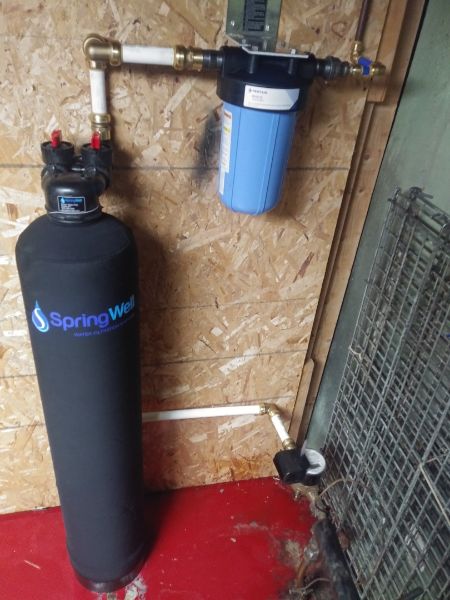
Pros and Cons of Cartridge-Based Systems
Pros:
- Cartridge-based systems don’t waste water
- The different stages of this system provide different filtration methods to remove a wider selection of water contaminants
- Cartridge filters are usually compact and don’t need much room at the install location
Cons:
- The filters in a cartridge-based system need to be replaced regularly, incurring higher cost over time
- Cartridge-based systems are more likely to cause a drop in water pressure and water flow rate
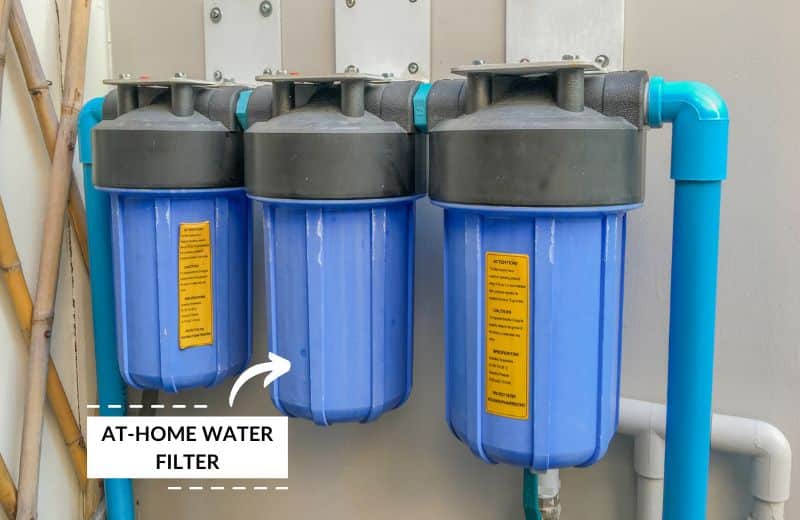
Further Reading:
📖 Every Type of Whole House Filter System, From Most to Least Common
Here, we’ve listed all the types of whole house water filtration systems on today’s market, from the most common to the least common options.
You don’t have to buy the most common whole house water filter just because it’s the most common. Your water properties, and the contaminants you want to remove, should dictate the type of whole house water filter system you buy for your home.
Activated Carbon Filter Systems
What Is It?
Activated carbon is one of the most popular filter media for a whole house water filtration system, thanks to its proven ability to remove a select range of contaminants using the process of adsorption. Activated carbon media is made from charcoal, coconut, bone char, or wood.
Carbon-based whole house water filters can remove or reduce chlorine and chloramine, contaminants that affect water’s taste and odor, herbicides and pesticides, and chemicals like THMs.
In a tank system, the activated carbon media may be the only media in the tank, or it may be accompanied by another media, like KDF.
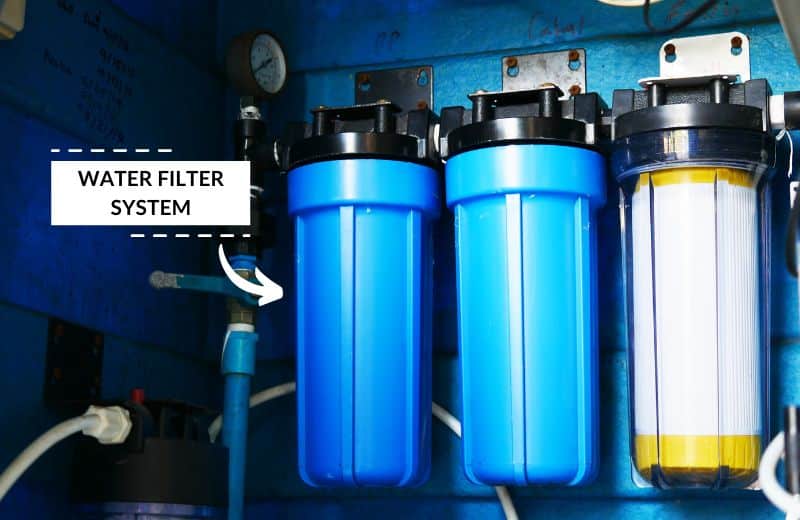
How Does It Work?
Carbon filters use a process called adsorption to grab contaminants out of water. The contaminants react with the activated carbon and stick to the surface of the media. Carbon filters typically have a very large surface area, allowing them to trap the maximum volume of contaminants as water flows through the media.
There are two types of activated carbon filters: granular activated carbon (GAC) filters and activated carbon block filters. GAC filters contain loose carbon granules, while activated carbon block filters contain bonded carbon powder. This doesn’t affect the effectiveness of the process, but GAC filters are usually used within whole home water filters because they allow for higher water pressure.
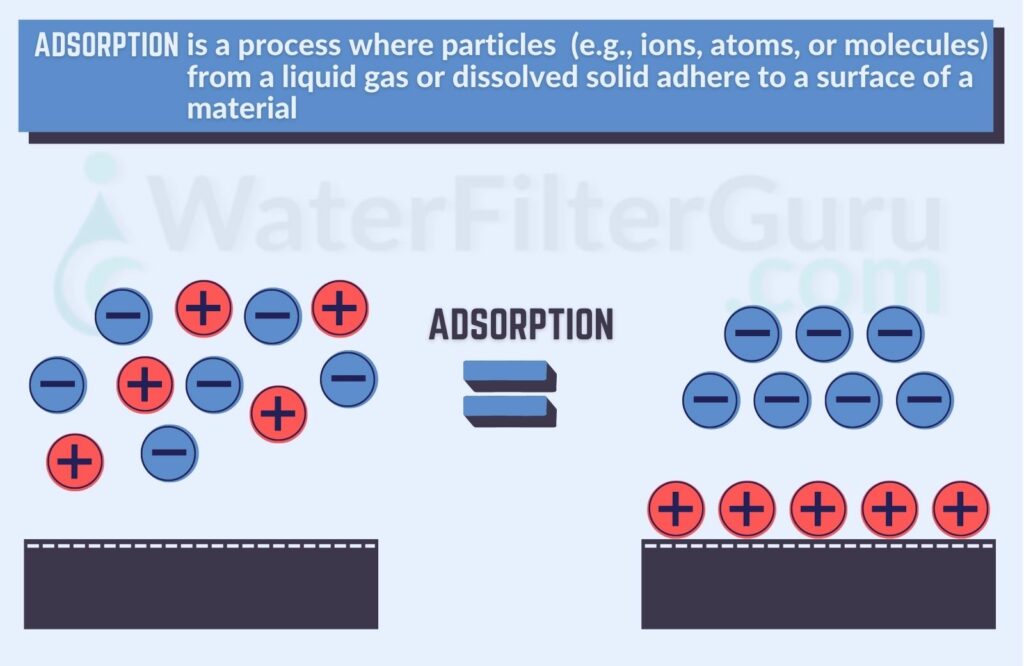
What Does It Remove?
Carbon-based whole house water filters remove chlorine and chloramine, contaminants that affect water’s taste and odor, herbicides and pesticides, and chemicals like THMs.
Pros and Cons
Pros:
- Effectively removes a select range of contaminants
- Improves the taste and odor of water
- Doesn’t use chemicals or require electricity
Cons:
- Filters or media don’t last forever
- Doesn’t target heavy metals
Related:
- The best whole home water filtration systems of 2025 money can buy
- Top rated carbon POE systems
Sediment Filters
What Is It?
Sediment filters are designed to remove large sediment particles from a home’s water supply. They’re commonly used as a pre-filter stage for whole house water filter systems, such as carbon tank filters and cartridge-based filters.
Sediment filters are also used as standalone filters, and are a popular choice for people who get their water from a private well (where sediment is more common).
Some under-sink systems use a sediment filter, but most sediment filters are designed for whole home installation.
How Does It Work?
There are two types of sediment filters on today’s market: spin-down filters and cartridge filters.
Spin-down sediment filters look like large pipettes, with a translucent design that lets you see the inside of the system. Spin-down filters trap sediment, which can be manually flushed away with the included flush valve, allowing the filter to be reused again and again before a replacement filter is needed.
Cartridge filters are more commonly available, and use filter media of a certain pore size to trap sediment particles. Some cartridge sediment filters are known as spun filters, and have layers of filter media with different micron ratings, trapping sediment of all sizes.
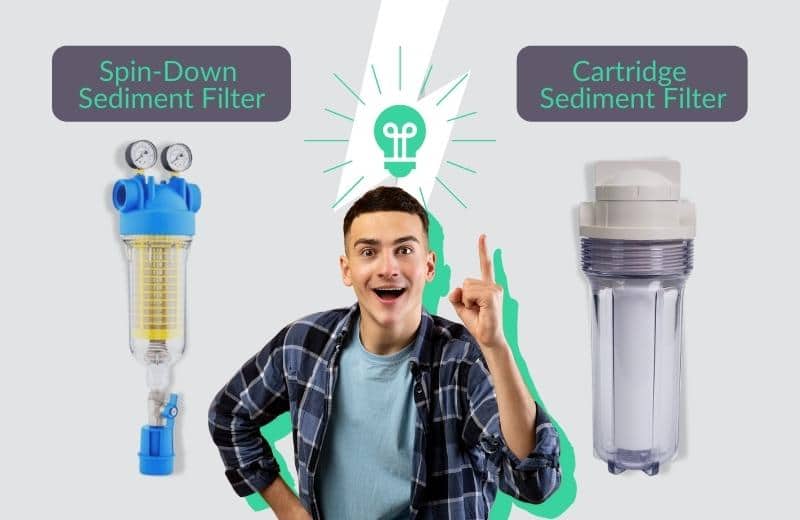
What Does It Remove?
Sediment filters remove grains of sand, silt, rust, dust, and dirt from water. This protects the water supply and potential later filter stages from abrasive sediment damage.
Pros and Cons
Pros:
- One of the cheapest whole house water filter options
- Often comes included with a multi-stage filter system so doesn’t need to be purchased separately
- Easy to install
Cons:
- Only targets large sediment particles
- Needs to be replaced frequently
Related: Read about the best sediment filters for well and municipal water here.
KDF Filters
What Is It?
KDF is short for Kinetic Degradation Fluxion. This type of media is made from high-purity copper-zinc granules, and reduces a selection of contaminants with a redox reaction (either oxidation or reduction).
The KDF process is certified by NSF. Typically, KDF filter media is used in a tank-based system, and can be combined with carbon media or used alone. Some cartridge filters also use KDF filter media.
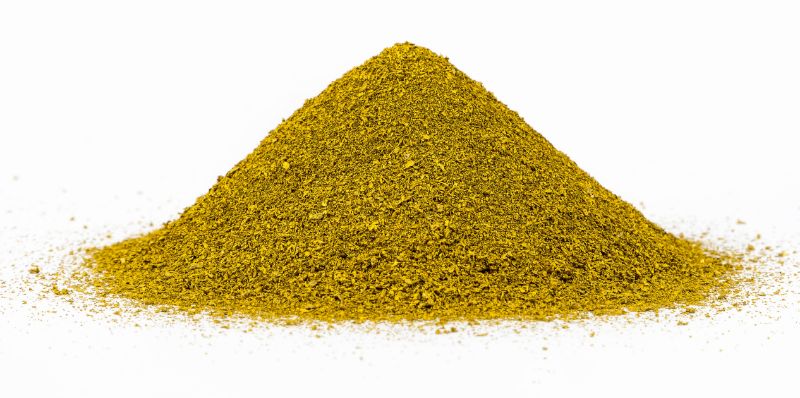
How Does It Work?
KDF filters water by converting contaminants into harmless particulates, which can then be removed when the filter backwashes. This chemical reaction results in electrons transferring between molecules, producing new elements.
There are many different granule variations of KDF, including KDF-55, KDF-85, KDF-F fine mesh, and KDF-C coarse mesh. You can learn more about the different types of KDF in this guide.
What Does It Remove?
Depending on the type of KDF whole house water filter, the media can remove heavy metals, iron, hydrogen sulfide, and chlorine. KDF is commonly used alongside activated carbon media to improve the overall filtration process, and in water softeners to boost efficiency.
Pros and Cons
Pros:
- Several variations to choose from
- Affordable cost
- Can support other filter media in a large filtration system
Cons:
- Can’t remove organic chemicals
- Needs regular backwashing
Catalytic Activated Carbon Filter Systems
What Is It?
Catalytic activated carbon (CAC) filters are a less popular alternative to the traditional activated carbon filtration media. CAC filters are useful for homes with a city water supply that has been disinfected with chloramine, not chlorine, as CAS is particularly effective at chloramine removal.
Again, you can find CAC filters in media-based tank systems or as a single filter stage in a cartridge system.
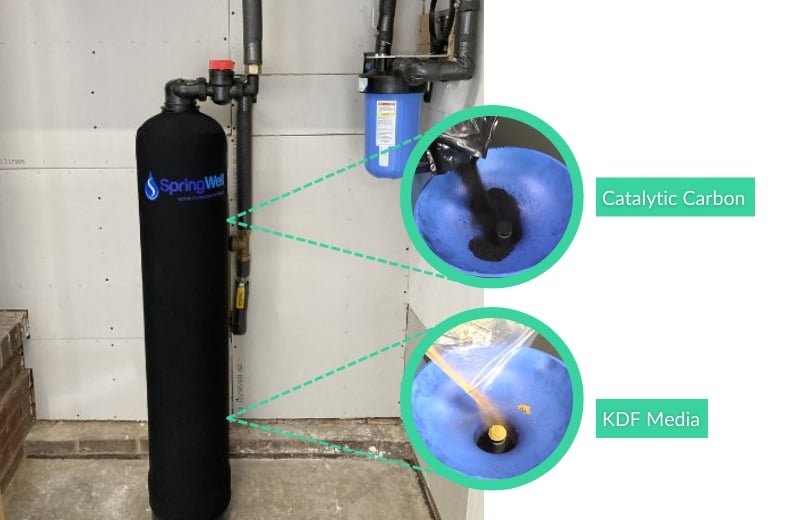
How Does It Work?
Catalytic activated carbon works similarly to a standard AC filter, but the media is tailored to chloramine removal.
CAC media is made by altering activated carbon’s surface structure with high-temperature gas processing, changing the media’s electronic structure. This increases the level of catalytic activity in the media.
Like activated carbon, CAC uses adsorption to trap contaminants in its media, preventing them from passing through the filter with the water particles.
What Does It Remove?
Catalytic carbon is primarily used to target chloramine and hydrogen sulfide gas, both of which affect the taste and odor of water. Catalytic carbon converts hydrogen sulfide into two types of water-soluble compounds: sulfurous acid and sulfuric acid. This type of carbon media can also reduce lead.
Pros and Cons
Pros:
- Removes chloramine more effectively than traditional AC
- Targets hydrogen sulfide and improves water’s taste and smell
- Faster chemical reaction than standard activated carbon
Cons:
- Still not effective in removing most heavy metals
- Can be costlier than traditional AC
Air Injection Filters
What Is It?
Air injection filters are the most popular whole house water filters for reducing iron, manganese, and sulfur in water.
An air injection filtration system consists of a single tank containing an air pocket and a media bed, such as birm or manganese greensand. This type of whole house water filter doesn’t need much maintenance and periodically flushes itself with backwashing.
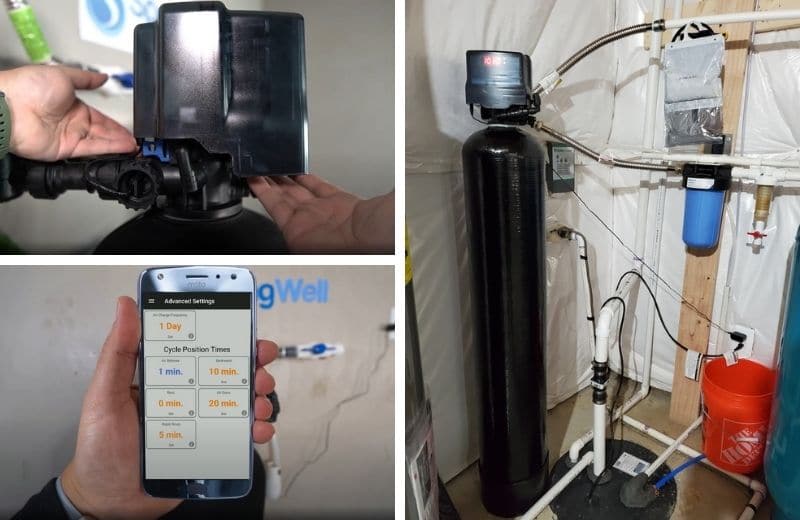
How Does It Work?
Air injection works by oxidizing iron, manganese, and sulfur. Water flows through an air pocket at the top of the tank, and when soluble contaminants come into contact with air, they’re oxidized.
In their new insoluble form, the oxidized contaminants can be easily removed from the water. When water flows through the birm or manganese greensand media bed, the oxidized contaminants become trapped in the media. The system backwashes periodically to remove the contaminants, preventing the media from becoming saturated.
What Does It Remove?
The three contaminants that air injection targets are iron, sulfur, and manganese. Iron is the main focus, and air injection can remove between 10 and 30 PPM of this contaminant, depending on the design of the system. Most air injection whole house water filter systems can remove between 3 and 5 PPM of sulfur, and up to 10 PPM of manganese.
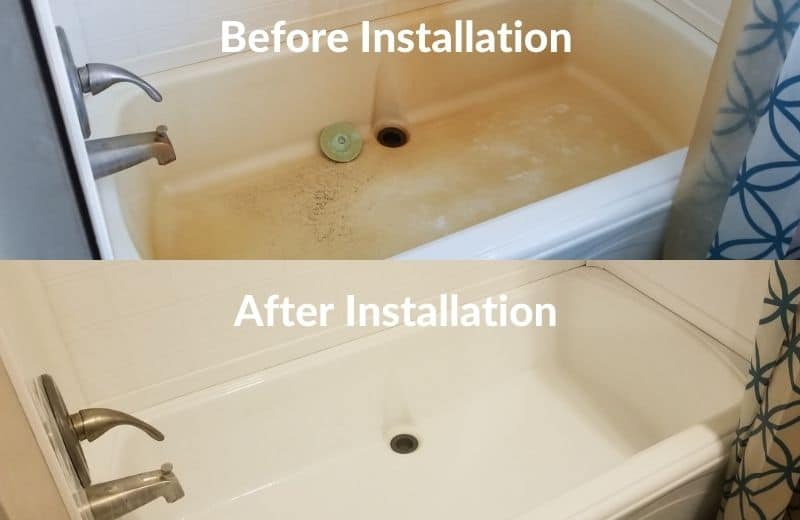
Pros and Cons
Pros:
- Minimal maintenance required – the media bed lasts for at least 6 years
- One of the most effective ways to reduce iron
- Improves the taste and appearance of water
Cons:
- System wastes water during backwashing
- Can’t be used to treat iron bacteria
Further Reading:
- All iron removal whole house systems
- Top rated systems for homes on well water
UV Purifiers
What Is It?
A UV filter uses a UV light to kill harmful microorganisms in water. UV filtration systems are typically installed as a final stage after a whole house water filter system. These filters can also be installed as standalone systems.
It’s common for UV systems to be used for homes with a well water supply, which isn’t disinfected before it travels to the home. UV lights require an electricity source to operate, and they need to be switched on around the clock to be effective.
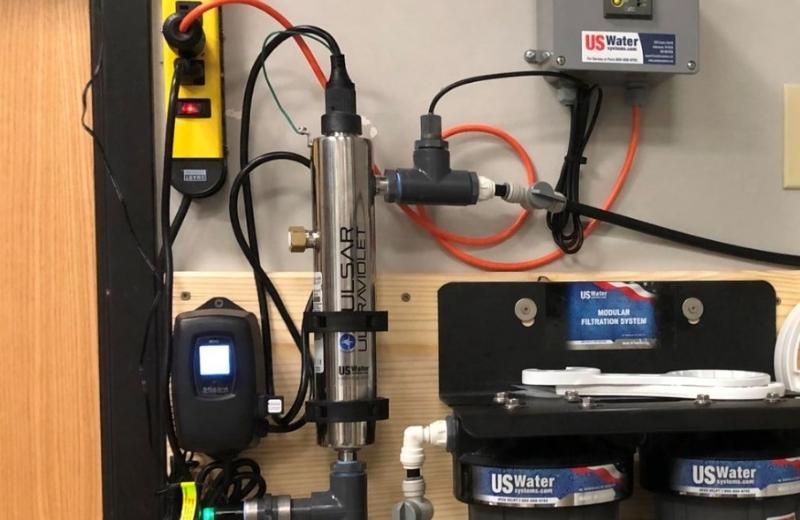
How Does It Work?
UV purifiers are simple systems consisting of two main components: a UV lamp and a sleeve. The lamp sits in the sleeve, and the system intercepts the waterline. This means that water flows through the sleeve and is purified before reaching your water heater.
UV systems release ultraviolet rays, which damage the DNA of microbiological contaminants, killing them and preventing them from reproducing. UV has a lifespan of around 1 year, so the lamp should be replaced annually.
UV systems aren’t technically filters. They don’t use filter media, and they don’t technically remove contaminants. Instead, they destroy them, preventing them from causing harm.
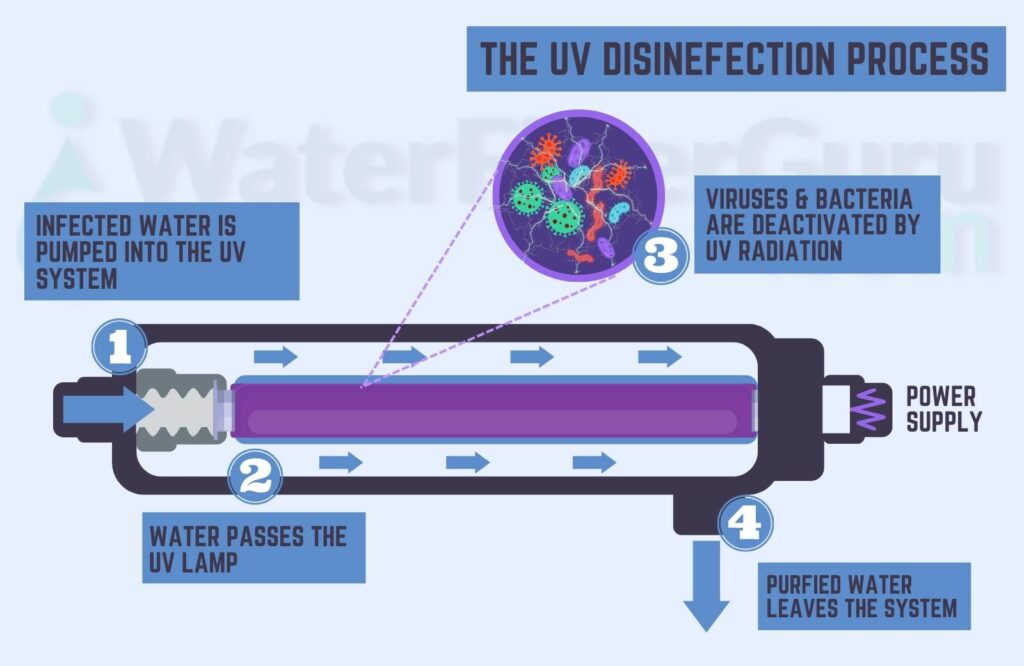
What Does It Remove?
UV filtration kills bacteria, viruses, cysts, protozoans, and fungi. The effectiveness of a UV filtration system depends on the quality of the water – UV doesn’t work on murky, sediment-heavy water. That’s why UV systems are commonly installed as a post-filter stage.
Pros and Cons
Pros:
- Requires minimal maintenance
- Doesn’t need chemicals to disinfect water
- Safe and environmentally-friendly
Cons:
- Needs constant access to a power supply
- May require pre-filtration
Read More: Best UV water purifiers for your home in 2025
Whole Home Reverse Osmosis Filtration Systems
What Is It?
Reverse osmosis (RO) water filters were traditionally installed as point of use applications, but nowadays, it’s becoming more common for RO units to be installed as whole house water filter applications.
Whole house reverse osmosis systems use several water filter stages, including a carbon filter, a sediment filter, and a post filter. The defining filter stage in an RO system is the semi-permeable membrane, which removes up to 99.99% of all water impurities.
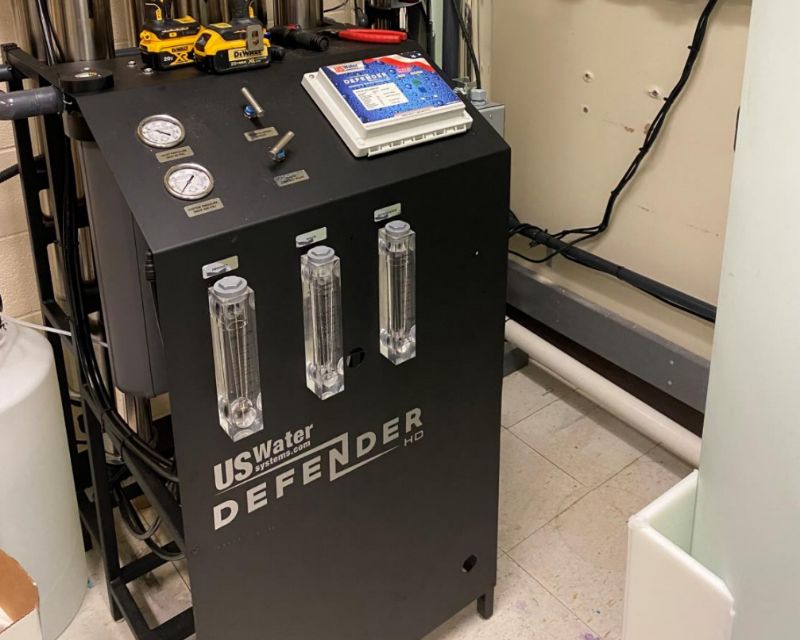
How Does It Work?
Reverse osmosis sends water through a series of filters at a high pressure. After passing through a sediment and carbon filter stage, water is forced through a semi-permeable membrane, which consists of tiny pores of 0.0001 microns in size.
The contaminants rebound off the membrane and linger in the RO chamber, where they’re washed away with a small amount of wastewater. Water particles are small enough to pass through the membrane’s pores, and water is treated in a final post-filtration stage before leaving the system.
RO is highly effective, but the reason why it isn’t considered the best option for whole-house filtration is because of its water waste. All RO systems waste water. While this isn’t so bad with drinking water filters, much more water is wasted in a whole house water filter, because it filters the water supply in your entire home.
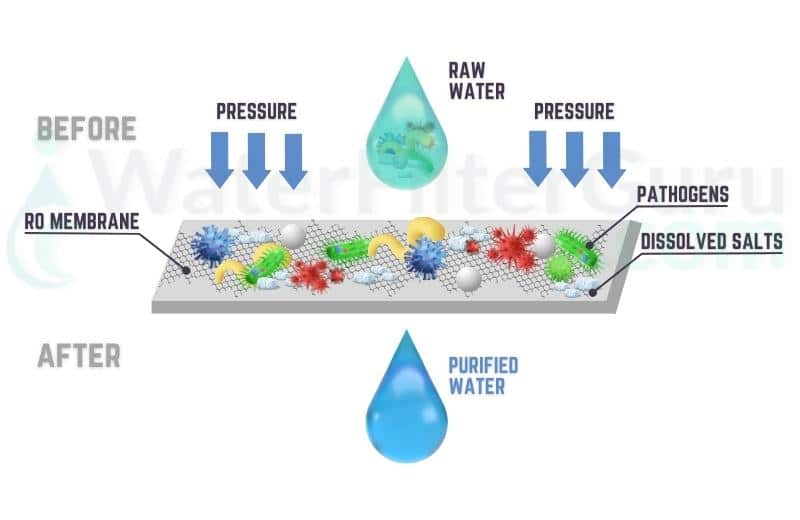
What Does It Remove?
RO removes a broad selection of contaminants, including chemicals, heavy metals, pesticides and herbicides, volatile organic compounds, disinfection byproducts, nitrate and nitrite, bacteria, and fluoride. RO also removes minerals and salts from water.
Pros and Cons
Pros:
- Highly effective filtration technique
- Targets chemicals, metals, and bacteria
- RO membrane lasts for at least 2 years before it needs replacing
Cons:
- Wastes water during filtered water production
- Lots of filters to replace
Read More: 2025‘s best whole house reverse osmosis water filters reviewed
Ultrafiltration
What Is It?
Ultrafiltration is similar to reverse osmosis. This type of whole house water filter uses membrane technology that removes contaminants down to 0.01 microns.
Again, ultrafiltration is most commonly used as an under-sink tap water filter solution, but whole house water filter systems using UF technology are available.
How Does It Work?
Ultrafiltration sends water through a hollow fiber membrane at a high pressure. Only particles that are small enough can pass through the membrane, leaving the remaining particles on the other side of the filter.
What Does It Remove?
Ultrafiltration removes bacteria, some viruses, organic suspended solids, and a small percentage of minerals.
Pros and Cons
Pros:
- No chemicals required
- Doesn’t waste water
- Removes microorganisms
Cons:
- Not commonly found as a whole house water filter system
- Needs a pre-filter
Calcite Filters
What Is It?
Calcite filters, or acid neutralizers, are a type of whole house water filter designed to balance out your water’s pH. This improves the taste of water and reduces the risk of contamination from corroded pipes (which is caused by acidic water).
Calcite filters typically come in cartridge form, and are either standalone filters or filter stages added on to whole house water filter systems.
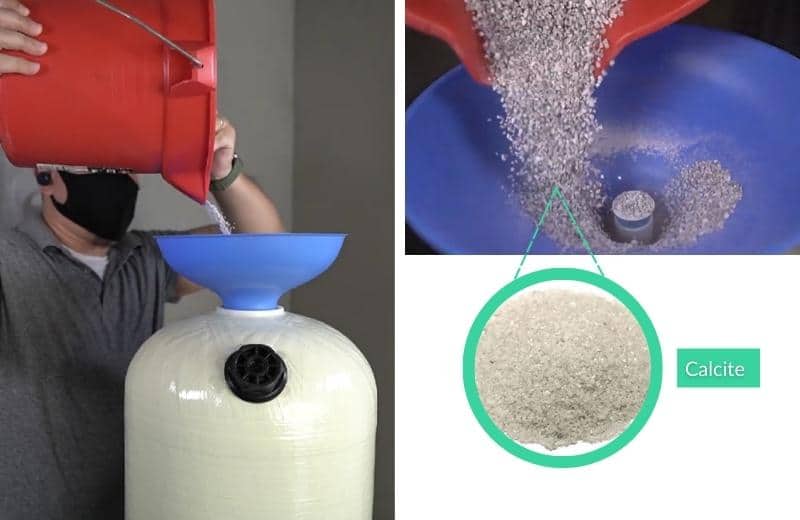
How Does It Work?
A calcite water filter introduces natural minerals to your water, increasing its pH and reducing its acidity. Typically, calcite filters use magnesium oxide and calcium carbonate to neutralize water.
When water flows through the filter, a small amount of the media dissolves, naturally increasing the water’s alkalinity. Some calcite filters need to be replaced frequently, while others can be backwashed to extend their lifespan.
What Does It Remove?
A calcite water filter doesn’t remove anything from your water. Instead, it adds healthy, alkaline minerals to a water supply. Calcite filters are usually included as a stage in whole house water filtration systems that remove a range of common contaminants.
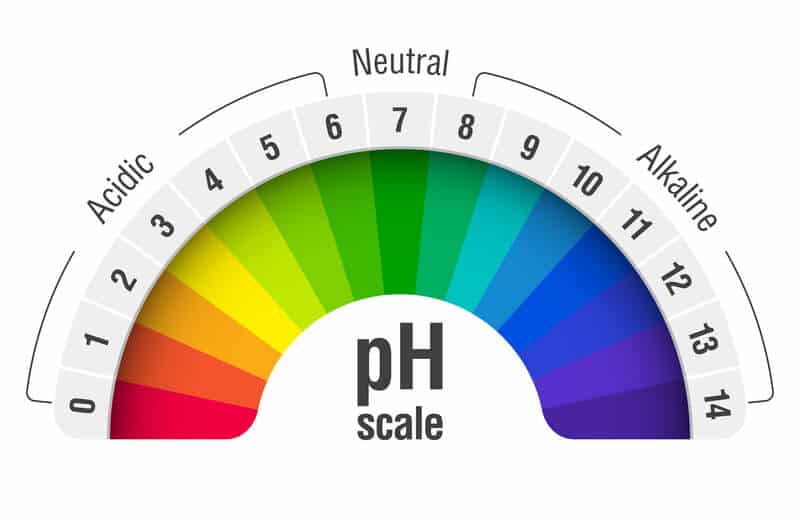
Pros and Cons
Pros:
- Improves water taste
- Reduces the risk of contamination from pipe corrosion
- Affordable to maintain
Cons:
- Doesn’t remove anything from water
- Not effective as a standalone water filter
See More: Best acid neutralizer systems for well water
